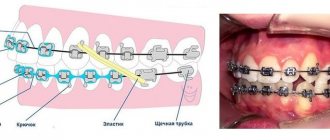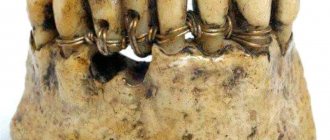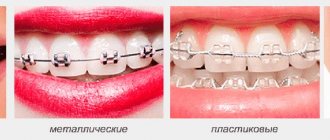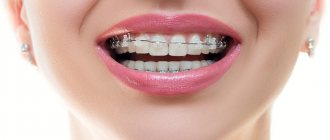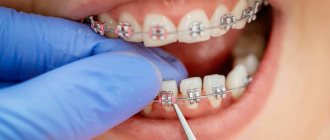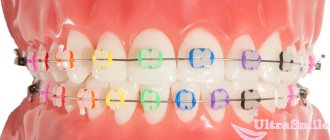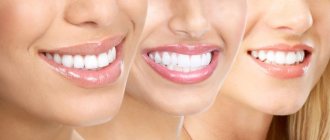History of creation | Working principle | Fixing the system | Withdrawal | Types of braces | Treatment phases | Photos of teeth before and after | Duration of treatment | Brushing teeth with braces | Addictive | Cost of treatment
Braces are a non-removable orthodontic device for the treatment of dental anomalies. Orthodontic treatment is a slow and complex process. The force is created by a metal arc installed in the grooves of the braces. Work productivity increases if the doctor and patient find each other. The design of the bracket system, the doctor’s experience and the patient’s responsibility lead to correct occlusion and stable results.
The material was verified by Anna Rimkevich, senior product manager at Ormco Russia.
A brace system is a tool for correcting a bite in the hands of an orthodontist. Teeth move under the influence of a constant weak force. To speed up the movement of teeth, the doctor uses additional elements: springs, chains, bite pads and elastic rods. After completion of treatment, a correct bite and an aesthetic smile will delight the patient for many years.
The result of orthodontic treatment
The goal of treatment with braces is to form the correct closure of teeth in the sagittal, vertical and transversal planes. In 1972, physician Lawrence Andrews formulated six keys to optimal occlusion in the permanent dentition. When correcting incorrect position of teeth and correcting the relationship between the upper and lower jaw, orthodontists of the 21st century are guided by the signs identified by the researcher:
- fissure-tubercle contact of the molars of the upper and lower jaws;
- crown angulation;
- crown inclination;
- lack of tooth rotation;
- tight approximal contacts;
- parallelism of the occlusal plane of the upper and lower jaw to the true horizontal.
The orthodontist forms the correct occlusion, improves the torque of the teeth and the exposure of the incisors. As a result of treatment, the doctor expands the dentition and creates an ideal smile.
What is an ideal smile? When a person smiles, the anterior teeth, premolars, and mesial surfaces of the first molars are visible. The cutting edges of the incisors and canines of the upper jaw follow the contours of the lower lip and form the arch of the smile.
result of bite correction
What are braces?
Braces, or rather brace systems, are dental structures for eliminating malocclusions and problems with incorrect position of teeth.
Alignment with orthodontic braces began to be practiced back in 1776 in France, but the heavy structures used then interfered with speech and extended beyond the mouth. More than a hundred years later, the device was radically improved in America. Today, the classic system looks different and consists of three main elements: ➢
braces - clasps that are attached to the teeth
➢
orthodontic arch
➢
fastenings (ligatures) for coupling the arch with the clasps
History of the creation of braces
Doctors of the ancient world of the 9th - 6th centuries BC straightened teeth using improvised devices. In 1728, surgeon Pierre Fauchard published a study, one chapter of which was devoted to orthodontics. In the 9th century, the American Edward Engle created the first prototype of the braces system. The scientist invented four devices:
- E-arc gold alloy;
- modification of the E-arch with pins and tubes;
- ribbon arc;
- edgewise braces.
The operating principle of the structures underlies the operation of 21st century braces.
The E-arch, which expands the dentition, was made of a gold alloy and fixed into rings installed on the molars. Each tooth was tied to an arch with wire. Subsequently, Engle refined the design: adjustable tubes appeared on each tooth and pins on the arch. The pins fixed the arch into the slots, the doctor adjusted the pins, and the teeth moved. The system was not actively used in clinical practice, and the E-arm remained an intermediate option.
Later, an American scientist created a ribbon arch. Engle replaced the tube design on each tooth with a vertical rectangular groove. The crowns of the teeth tilted under the influence of the arc, but the roots remained in place. The limitation in the width of the groove and the low elasticity of the arc did not allow the torque to be controlled.
In 1928, Edward Engle designed the edgewise braces system. The scientist compared the geometry of the groove and the arc and replaced the ribbon arc with a rectangular wire. Engle established the slot size of 0.022 x 0.028 inches, which is what 21st century orthodontists use.
Edgewise braces were not wide enough to rotate the tooth under the force of the archwire. To achieve the result, orthodontists installed two braces on the tooth at once. The design formed the basis of ligature systems. With the development of orthodontics at the beginning of the 20th century, the gold alloy from which the arch was made was replaced by stainless steel. The increased rigidity of the steel compensated for the reduced arc thickness. A groove size of 0.018 x 0.025 inches has appeared, which, along with 0.022 x 0.28, is used in practice by orthodontists.
Damon Clear with arc
How do braces straighten teeth?
It is designed by nature that our teeth can change position - independently or under the influence of external forces. Thanks to this property, orthodontic treatment with braces becomes possible. Its principle is the following.
- Based on the patient’s clinical picture, the doctor plans a trajectory of movement for each tooth; one bracket is responsible for one dental unit.
- During the process of fixing the braces, the clasps are connected to each other by an arch with shape memory, which it tends to take over time.
- Under the influence of the arc, the dentition begins to take the desired position.
- During treatment, the archwire is replaced with a more rigid one to increase the impact.
How do braces work?
The system consists of brackets fixed to the teeth, into the groove of which an orthodontic arch is inserted, and additional elements. On the sixth and seventh teeth, the doctor installs buccal tubes to secure the ends of the arch. The force on the tooth depends on the rigidity of the arch and the position of the arch in the bracket groove, the use of additional metal and elastic elements:
- metal ligatures;
- chains;
- springs;
- bite pads made of composite material or bite braces;
- buttons;
- hooks;
- additional arcs;
- elastics.
Damon Q2 with hook
Metal ligatures press the archwire tightly against the bracket, and springs and elastic chains create the force to move individual teeth. Using additional elements of the system, the doctor controls the impact on each tooth.
The arc straightens and pulls the bracket, the force is transmitted to the tooth and causes a process of aseptic inflammation in the surrounding tissues. Osteoclast cells destroy bone at the junction of the root and the alveolar wall. On the other side of the tooth, osteoblast cells synthesize new bone tissue. The balance of osteoblast and osteoclast activity ensures natural tooth movement. Braces direct and accelerate the physiological effect of the force of the arc and additional elements.
arc in groove Damon Q2
The operating principles of self-ligating and ligature systems differ. Self-ligating passive braces provide physiologically adequate force to move teeth due to low friction of the archwire in the closed space of the groove. In self-ligating braces with an active type of ligation, the clip and the arch press against each other. In classic ligature braces, the arch is held tightly in the groove by elastic or metal ligatures.
Where to remove braces and how much does it cost?
Braces are removed at the dental clinic where the treatment is performed, for example, Family Dent. The cost of the procedure varies widely - from 2,700 to 12,500 rubles. for both jaws. The price depends on:
- difficulties in dismantling the system;
- subsequent procedures of professional cleaning, polishing, remineralization;
- clinic class;
- specialist rating, etc.
The cost of dismantling lingual braces is 2 times more expensive due to limited access to structural elements.
Fixing the system
Before installing braces, the orthodontist conducts a diagnosis and agrees on a treatment plan. The doctor refers the patient to professional oral hygiene. The procedure is necessary to keep the enamel under the braces intact.
The doctor treats the area of fixation with orthophosphoric acid and applies a primer. The primer contains fluorine compounds that penetrate the enamel. Fluorine molecules are embedded in the crystal lattice of hydroxyapatite enamel and reduce permeability to carious bacteria. Before fixation, the doctor applies light-curing materials, for example Blugloo, Grengloo, Enlight, to the base of the bracket.
Fixation methods
The doctor fixes the braces directly or indirectly. Regardless of the method, installation is painless for the patient.
In the case of the direct method, the orthodontist positions each bracket according to anatomical landmarks, the projection of the root in the bone tissue and the inclination of the tooth manually. Next, the material is illuminated with a polymerization lamp. The patient spends 30 to 50 minutes in the chair.
With the indirect fixation method, the manipulation takes 10–15 minutes and does not cause discomfort to the patient. The procedure consists of several stages:
- The orthodontist manually positions each bracket on plaster models of the jaws;
- transfers braces to a silicone tray;
- applies adhesive to braces;
- During the visit, he moves the elements of the system from the tray onto the prepared enamel and illuminates it with a polymerization lamp.
Fixation of the structure is a key stage of treatment, regardless of the method used. The orthodontist adjusts the width of the teeth and creates an aesthetic smile arch through the correct positioning of each element of the system. Braces work out torque, rotation and angulation. The doctor installs the arc into the slots and releases the patient until the next activation.
What kind of system is this?
Dental braces are a complex orthodontic structure that consists of several main elements.
The braces themselves are a kind of clasps that are attached to the surface of the tooth and serve to hold a special arch. It is this that has the effect - having “shape memory” , the material from which the arch is made tends to return to its original state, thereby putting pressure on the teeth. Another element of many brace systems is the fastenings that connect the arch and braces.
Removing braces
After completion of treatment, the long-awaited moment comes - removal of braces. Using special atraumatic forceps, the orthodontist peels off the bracket from each tooth with one movement of his hand. The patient hears a click and the bracket painlessly moves away from the enamel surface.
Next, the doctor grinds off the remaining glue and polishes the enamel to return the tooth to its original appearance. Grengloo bracket bonding material reduces the excessive impact of rotating instruments during polishing: removing adhesive from the tooth surface does not cause additional damage to the enamel. When there is no green material left, the enamel surface is cleaned.
Doctors from the Department of Orthodontics at the Tabriz University of Medical Sciences in Iran conducted a study and compared the differences in enamel damage after removing two brace designs - with a mesh-type base and with posts.
Researchers have scientifically substantiated the influence of the design of the bracket base on the adhesion strength to the enamel. According to the results of a study by orthodontists, at the base with columns the degree of adhesion to the enamel is higher. At the same time, braces with a mesh base cause less damage to the enamel when removed.
Doctors of the 21st century prefer systems with a mesh base to reduce the number of enamel microcracks during debonding. An example is the Damon Q and Damon Q2 self-ligating braces and the Mini Diamond ligature systems. Ormco's patented bracket base treatment makes removal safe for the enamel.
Damon Q2 with mesh base
Common bite pathologies
To understand why you cannot insist on local correction of the bite, it is worth getting acquainted with the main deviations in jaw closure. The description of pathologies shows that correction should be carried out comprehensively. Otherwise, treatment will only worsen the problem, even if there are no visible prerequisites for this.
To diagnose a bite, doctors rely on photographs of the jaws - a comprehensive x-ray examination:
- OPTG (orthopantomogram) – a panoramic image of the dentofacial rows;
- CT – computed tomography of one or two jaws;
- TRG (teleradiogram) – lateral projection of the skull.
The most common malocclusions:
- Open – when the jaws are closed, there is no contact in the frontal zone or in the area of the chewing teeth.
- Deep - the lower incisors overlap the upper antagonist teeth by more than a third.
- Distal – the upper row of teeth is pushed forward.
- Mesial – the lower jaw protrudes forward.
- Crossed - the jaw rows are changed in shape or size in the horizontal direction.
Any pathology requires complex correction, since with partial displacement of teeth, the existing disproportion will only intensify. Moreover, with almost correct closure of the jaws, movements of the lower teeth can provoke a violation of occlusion - displace the cutting edges or chewing surfaces of individual units relative to each other. Visually, the teeth will become straight, but the bite will be disrupted.
Soldatenkova Alina
It is impossible to immediately say what orthodontic treatment is indicated for the patient. Just guess. A constructive dialogue begins after receiving x-rays, where you can see not just the current picture, but also hidden processes - impacted and dystopic teeth, the condition of the roots and periodontal tissues. After studying the images and OPTG, we can discuss the installation of braces on the lower jaw or another treatment option.
Types of braces
The structures are classified according to the material of manufacture, location in the oral cavity and type of arch fixation. Here are examples of each type of braces.
Material of manufacture
1. Metal braces . Self-ligating Damon Q and Damon Q2 are made from 17-4 stainless steel alloy. In addition to orthodontic products, the high-strength alloy is used in the aviation and chemical industries. An example of metal ligature braces is Mini Diamond and Orthos.
Damon Q2 with lid open
Mini Diamond model
2. Devices made of bioinert titanium alloy . This material is chosen if the patient is allergic to nickel or chromium. An example is the classic Titanium Orthos braces.
3. Ceramic systems . Damon Clear/Clear2 translucent braces are made from durable polycrystalline aluminum oxide (PCA). The period of adaptation to foreign structures in the oral cavity increases, since Damon Clear is larger than metal Damon Q.
translucent Damon Clear
4. Braces made from artificially grown sapphire . Inspire Ice transparent ligature devices have durable wings that do not break off under stress.
transparent ligature Inspire Ice
Location in the oral cavity
The orthodontist fixes the braces vestibularly or lingually. For vestibular localization, the elements are glued to the visible part of the teeth. An example is Damon self-ligating braces. Lingual systems are installed on the dentition from the tongue side, the design is invisible to others. The adaptation period to internal braces is longer than to vestibular systems: it is not easy for the tongue to get used to a foreign structure in the oral cavity. An example is STb braces. Due to the fact that the bases of the braces are made individually according to exact impressions of the jaw, the cost of lingual systems is higher.
vestibular ligature braces Mini Diamond on typodont
Arc fixation type
The arch is attached to classic edgewise braces with elastic and metal ligatures. Ligature braces correct the position of individual teeth and correct complex dental anomalies. The ligatures press the arc tightly against the groove, increasing friction in the system. Example – Mini Diamond and Orthos.
ligature Orthos made of metal
Self-ligating brackets hold the archwire without ligatures: the cover of the structure closes and closes the groove space. In devices with a passive type of ligation, the groove does not interfere with the movement of the arc, the cover is motionless, the arc slides without obstacles, and friction in the system is minimal. The Damon Q and Damon Q2 systems work out the parameters embedded in the braces and start the physiological process of moving teeth.
closed Daimon Q
In active self-ligating structures, the clip puts pressure on the archwire and has a mechanical effect on the entire system. Teeth move in an adequate force zone under the influence of load vectors.
The best non-ligature braces
The most popular brands of non-ligation systems are Clarity, Damon, H4, Smartclip.
Damon is one of the most famous brands of ligature-free braces. The line includes systems for different cases - various malocclusions and tooth position. A characteristic feature of these systems is the presence of a flap attachment, which facilitates the procedure for replacing arches and reduces correction time at the dentist. Damon Q braces are a universal tool for working with various occlusion problems, from mild pathologies to severe crowding of teeth.
Damon Clear braces are ceramic systems that have one feature: they have a special element that covers the metal arch. Due to this, the visibility of metal elements in this system is significantly reduced. Transparent systems have proven themselves and are widely used to correct various malocclusions.
Clarity SL braces are durable ceramic systems, the peculiarity of which is a groove that slides well in the lock - thus, the pressure of the brace system on the teeth is better distributed, which means the treatment process itself is more comfortable.
Ortho Classic H4 braces have a unique design and are widely used to correct various malocclusions. They do not exert strong pressure, due to which the treatment is comfortable and painless, but at the same time quite effective. The bases of each bracket are set slightly higher than in other systems, allowing the system to be partially hidden under the upper lip - this can also add to the aesthetics of the smile.
Smartclip metal braces are a system with a snap mechanism. It consists of iron locks with horizontal grooves, an arc and nitinol clips. The arch is fixed not with the help of an elastic ligature, but with these clips. The system provides for the release of the arc when the applied frictional forces exceed normal values - which is why there is practically no discomfort during treatment.
Which braces are more profitable to install?
Self-ligating and ligature braces correct the bite and correct complex dental anomalies. Non-ligating systems are more expensive, but the installation of self-ligating structures reduces the number of visits to the clinic. At a lower price for edgewise braces, the patient visits the orthodontist an average of 24 times during treatment, 2.5 – 3 years. When installing self-ligating systems, approximately 12 visits to the doctor are required. The course lasts from 1 to 2.5 years.
Clinic management is often not ready to purchase expensive systems and pay for additional training for orthodontists. Doctor A.V. Tikhonov economically substantiated the advantages of installing ligature-free braces. The orthodontist compared the rate of arch replacement during activation of self-ligating structures and traditional models with ligatures. On average, removing and installing the arch takes 8 minutes. 14 sec. on classic systems and 1 min. 21 sec. – on self-ligating ones. Usually the arches are changed on the upper and lower jaws - the duration of the manipulation is doubled.
treatment on Damon Q2
According to the researcher, taking into account the reduction in treatment time and the number of visits to the doctor, ligature-free braces are more economical for the clinic and the patient. The ergonomics of working with the ecosystem of Damon braces and additional elements reduces the appointment time and the total financial costs of the person visiting the clinic.
Differences between ligature and non-ligature braces
Non-ligature and ligature braces are designs that are used to correct malocclusion and tooth position. These systems are characterized by different strengths of action, and in each specific case the doctor selects the most appropriate solution.
The difference between ligature and self-ligating braces is the presence and absence of an auxiliary element - a ligature. This largely determines the aesthetics of the system and the speed of obtaining correction results.
There are the following differences between ligature and non-ligature braces:
- Patients report less pain when starting to wear self-ligating systems. The teeth shift slowly, so the discomfort is less than when wearing ligature systems;
- performing hygiene procedures is easier when wearing self-ligating braces. Each meal must be completed by cleansing the oral cavity using special brushes, brushes and an irrigator. More compact sizes and the absence of ligatures make the cleansing process simpler and faster;
- ligature systems help to get results faster - their action is more powerful, they are able to eliminate gross malocclusions;
- aesthetics of non-ligature systems - such braces stand out less against the background of the crown, so the design does not catch the eye. And transparent sapphire braces imitate the shade of your own teeth, add a special shine and look attractive.
After a period of bite correction with both ligature and non-ligature braces, the orthodontist will prescribe the wearing of structures to consolidate the results obtained - the retention period of treatment begins. Wearing retainers and special mouthguards may be required for 1.5-2 years, and in some cases longer, up to constant wear.
One of the most significant advantages for the patient is a relatively shorter appointment with a doctor and a reduction in the number of visits - it is enough to undergo correction once every 6-8 weeks, which is half as often as when using ligature braces.
Phases of orthodontic treatment
Orthodontic treatment consists of four stages:
- leveling;
- basic mechanics stage;
- detailing and completion;
- retention.
Leveling
After fixing the braces, the leveling stage begins: the doctor installs round arches. The sequence of arch replacement is standard; if necessary, the orthodontist adjusts or supplements the protocol.
Protocol for replacing wires during treatment with Damon:
- 0.014″ CuNiTi – 10 – 12 weeks;
- 0.016″ CuNiTi – 6 – 8 weeks (intermediate arc if necessary)
- 0.014x0.025″ CuNiTi – 10 – 12 weeks;
- 0.018x0.025″ CuNiTi – 4 – 6 weeks;
- 0.019x0.025″ TMA or SS.
arc in groove Damon Q
0.013″ wires are typically used for severely crowded teeth. The higher the degree of crowding, the more difficult it is to install the arch into each groove. For moderate to mild crowding, the doctor begins treatment with an arc with a cross-section of 0.014″.
Round arches of low rigidity are made from a thermoactive nickel-titanium alloy with the addition of copper. The temperature of the oral cavity activates the physical properties of the metal, and the arc straightens to its original state. The doctor changes the arches in accordance with the treatment protocol. Thanks to the initial arches of low rigidity, the alignment of the dentition occurs, the rotation and position of individual teeth are corrected.
Correctly selected braces torque at the beginning of treatment reduces the number of visits at the final stage.
Basic Mechanics
After the leveling stage, the doctor installs rectangular arches. CuNiTi arches with a cross section of 0.014″, 0.016″ and 0.014x0.025″ are used to completely correct tooth rotations, begin to practice angulation and torque, and create the shape of the dentition. Steel, TMA and nitinol rectangular archwires are used to stabilize the dentition, close spaces, control torque, angulation and rotation.
girl with Damon Clear
During the basic mechanics phase, the doctor sometimes needs to re-bond the braces. This is a standard manipulation that does not cause any difficulties for the orthodontist. The position of the teeth and the vector of force application change, the doctor re-fixes the braces so that the teeth move in the right direction. At this stage, a complex change in the bite occurs; the doctor prescribes elastics. The doctor bends the arches, closes the interdental spaces, makes occlusal linings made of composite material, secures the hooks and installs microscrews.
Final stage
At the final stage, the doctor carries out the details: corrects the position of individual teeth, bends the arches and re-prescribes the scheme for wearing elastics. At the final stage, the doctor uses rectangular TMA 0.019x0.025″ archwires to create detailed bends and then softly transition to 0.019x0.025″ steel archwires, if necessary. A large selection of Damon torque options due to the implementation of the braces prescription allows the doctor to reduce the number of bends on the arches. The orthodontist corrects torque: the vestibulo-oral inclination of the tooth in the sagittal plane. Steel arches with a cross section of 0.019x0.025″ fill the groove, and the bracket fulfills the parameters laid down in the groove.
Retention period
To consolidate the results of orthodontic treatment, the doctor installs a retainer - a metal wire on the palatal and lingual surfaces of the anterior group of teeth. At the age of 25, the formation of the bones of the facial skeleton ends. Up to this age, patients wear a retainer twice as long as treatment with braces. After 25 years, a wire retainer is installed on both jaws for life. Regardless of age, doctors recommend wearing a transparent retention mouthguard at night. If the patient does not follow the doctor's recommendations during the retention period, the teeth may return to their original position.
At what age are braces placed?
The mobility of teeth in the jawbone persists throughout a person’s life, therefore, the answer to the question “Can braces be placed on crooked teeth in adulthood?” - positive. However, correcting a child’s bite with braces is much easier.
You can begin treatment as early as 9 years of age, even if not all baby teeth have been replaced by permanent teeth. The most optimal age for installing braces is 12 - 13 years old, but even at 30, braces will show good results. It will just take more time.
How to choose a brace system
The primary task for the patient is to find a doctor with whom a trusting relationship will be established. The orthodontist will conduct a diagnosis, discuss a treatment plan and offer several braces to choose from. The doctor recommends braces based on the patient’s financial capabilities, the complexity of the clinical case and the anatomical features of the dentition. The decision-making is influenced by the doctor’s personal preferences - some specialists work only on self-ligating braces using the straight arch technique, others prefer a multi-loop arch and ligature structures.
young man with Ormco translucent self-ligating braces
Ceramic and sapphire systems are chosen to partially camouflage orthodontic treatment. Bite correction with clear braces takes longer than with metal Damon Q braces due to the higher friction of the archwire and ceramic groove bottom.
treatment with Inspire Ice
What can be achieved?
Many people think that after undergoing a course of treatment with braces, a person only gets straight teeth that look beautiful and natural . This is true, however, this is only part of what such orthodontic devices can provide.
First of all, chewing function is restored, which is more important than even the external beauty of the teeth. After all, chewing is the first stage in the digestion and assimilation of food.
It also eliminates the possibility of problems with the joint connecting the jaws. In addition to the alignment of the teeth themselves and their rows, the face changes, the lines become more regular and attractive.
All this relieves the patient from many psychological problems and complexes that arise due to malocclusions and pathologies.
Photos of teeth before and after braces
Trust in a doctor consists of many factors: reviews and recommendations from friends, a well-conducted consultation, doctor’s certificates, diplomas and awards, photos of clinical cases “before” and “after” of treatment with braces published on the Internet. Doctors actively maintain groups on social networks and blogs on clinic websites, post videos on YouTube, and post photographs with the results of orthodontic treatment.
deep bite
high crowding, flat profile
moderate crowding, asymmetry
high degree of crowding, open bite, posterior crossbite
case without removal
bilateral crossbite with a high degree of crowding of the anterior group of teeth in the upper jaw
Prerequisites for bite problems in children
A visit to an orthodontist is a mandatory stage of medical examination for children and adolescents. The growth of the dental system is determined by various parameters: hereditary factors, environmental features of the region, bad habits of the child and psychological disorders.
Bad habits in children cause abnormalities in the growth and development of the facial skeleton and teeth. Prolonged thumb or pacifier sucking and insertion of the tongue between the teeth creates an open bite. Sleeping with your hand under your cheek causes misalignment of the jaw and teeth and causes the development of a crossbite. The infantile type of swallowing forms a distal bite. In such situations, it makes sense for parents to contact a child psychologist. An orthodontist corrects dental anomalies, but does not treat neurological and psychological disorders. After completing the psychological preparation of the child, parents and the doctor will have to choose a bite correction system.
Alternative to treatment with braces
An alternative to braces is aligners. Transparent hard aligners are used to move teeth in cases where the patient has increased aesthetic requirements. The aligners are made in the laboratory on a 3D printer based on an impression of the jaws. Patients change aligners in the order specified by the doctor. The disadvantage of aligners is the high cost of treatment, but the advantage is the aesthetic component: the aligners are invisible to others. Treatment with aligners takes longer and is suitable for clinical cases of mild to moderate complexity.
The doctor attaches attachments made of composite material to the teeth, on which the mouth guard presses. The teeth move slowly; halfway through the treatment, the orthodontist takes an impression of the jaw and sends it to the laboratory to make new aligners.
What methods are used to correct the dentition after braces?
- Due to the inability to carry out hygienic cleaning while wearing braces, teeth can noticeably change color. Teeth whitening after braces can help get rid of unpleasant yellowish or gray tints and dark spots.
- If everything is in order with the functionality of the teeth, then indirect and direct methods can be used to restore their aesthetics.
- The quickest way is to restore a tooth using the direct method - by correcting the shape of the dental crown by layer-by-layer application of photopolymer materials of carefully selected shades. Photopolymers are most often used to correct the uneven cutting edge of the central incisors.
- Indirect ones will require several visits to the doctor. The shape of the tooth will be corrected using an individual microprosthesis made from an impression - a veneer or lumineer, glued with dental cement to the prepared tooth surface.
Partial bracket system
For children in the period of changing temporary teeth to permanent ones, a “2 by 4” system is installed. Braces are fixed on four incisors and two molars. The design is used to close large interdental spaces when there is insufficient space for permanent teeth, early removal of temporary teeth to save space. Often, a 2-by-4 system prepares a child for primary orthodontic treatment with a full brace system. Braces are fixed at 6–7 years of age, when the first permanent molars erupt.
There is no age limit for orthodontic treatment. At any age, braces are firmly fixed to the enamel, and teeth move. Implants or ankylosed teeth in the mouth serve as support and do not move or participate in orthodontic treatment.
Is it possible to change the situation?
1. If desired, bringing your smile to perfection will not be difficult and will not always require significant investments. After all, the first, most important, most necessary stage has already been completed. Orthodontic treatment corrects your bite, straightens your teeth, and prevents more serious dental problems. And modern methods of artistic (or aesthetic) dental restoration will help restore the aesthetics of the dentition.
2. Adults are able to solve the dilemma themselves: whether to continue treatment if they don’t quite like the smile, or limit themselves to the achieved result.
Duration of treatment
How long do you wear braces? Treatment with ligature structures averages 2.5 – 3 years. Self-ligating devices are usually worn for 1 – 2.5 years. The duration of treatment depends on the model of braces, the experience of the doctor, the complexity of the clinical case and cooperation with the patient. If you do not wear elastics and do not follow the orthodontist's recommendations, treatment will slow down.
girl with Mini Diamond metal braces
The patient comes to the appointment with the regularity specified by the doctor. At the initial stage of treatment with a self-ligating brace system, the intervals between visits are 8 – 10 weeks. During the basic mechanics phase, the patient visits the orthodontist every month. When installing ligature structures, he comes for activation at least once a month at each stage of treatment.
teenagers with Ormco braces
Duration of treatment and principle of action
It is impossible to name the exact duration of treatment without conducting thorough research. It depends on a very large number of factors, among which the main one is the severity of the bite pathology.
This also includes the patient’s age and some individual characteristics of his bone tissue.
The fact is that the principle of operation is based on the fact that the teeth in the sockets, although firmly fixed, are surrounded by tissue, which can, with constant exposure, change its properties - become less or more durable. Braces apply slight, constant, long-term pressure on each tooth in a specific direction, causing it to move.
On average, wearing such orthodontic structures takes about one and a half to two years. Sometimes, in very simple cases, 5–8 months is enough, and sometimes, on the contrary, treatment lasts up to three or more years.
How to brush teeth with braces
Regardless of the type of braces and the number of visits to the clinic, a person needs to carefully monitor their oral hygiene. Orthodontic patients follow a diet. Doctors recommend eliminating sticky foods: toffee, halva, nougat, chips, chewing gum, consuming with caution and cutting hard vegetables and fruits into pieces. It is not recommended to drink coffee, red wine and other drinks with dyes. Orthodontists advise avoiding cold or very hot foods: sudden temperature changes damage metal and sensitive ceramics in the oral cavity.
With braces, brushing your teeth becomes more difficult. Using circular movements of an orthodontic toothbrush, the patient removes food debris and plaque from the vestibular surface of the teeth and the space around the bracket. The internal and chewing surfaces are cleaned with a manual toothbrush. The space around the braces and in hard-to-reach places is cleaned with a monotuft brush and dental brushes. Doctors advise using superfloss and irrigator.
It is necessary to brush your teeth three times a day after meals and perform professional oral hygiene in the clinic every 2 to 4 months. By following the doctor's recommendations and maintaining oral hygiene, the patient speeds up treatment.
Braces do not damage the enamel; caries occurs as a result of poor hygiene. The intensity of plaque depends on the type and size of the structure, but the main factor is the patient’s willingness to brush their teeth thoroughly and regularly. Caring for the oral cavity with small self-ligating appliances is easier than with ligature structures. Food remains under elastic and metal ligatures, which leads to the formation of caries.
Braces for extracted teeth
It is possible to install an orthodontic structure in the absence of one or more teeth, but it depends on the specific clinical picture. For example, it is quite possible to straighten a slight curvature in the frontal zone, even if there are no molars in the row. But is it possible to use braces to close a void when supporting teeth are missing? In this case, installing a system makes sense only if we are talking about 6, 7 and 8 teeth. If the figure eight (wisdom tooth) is missing, movement is impossible, since the chewing teeth will not be enough for full functioning.
Getting used to braces
The patient gets used to the braces system in the mouth within a couple of weeks. When the physiological movement of teeth begins, people experience discomfort due to aseptic inflammation of the bone. Patients with self-ligating braces stop feeling pain after a couple of days; when installing ligature structures, the discomfort goes away on the sixth day. The level of discomfort is influenced by the pain threshold, which is individual for each person.
Sometimes, at the initial stage of treatment, nitinol round wires cause discomfort. A glass of cold water relieves discomfort. Due to the physical properties of the thermal activity of the metal, the tension decreases and the discomfort goes away.
The metal of nitinol arcs is in one of two phases. When the temperature changes, the crystal lattice of the alloy changes from the martensite state to the austenite state and back. The doctor inserts a thermoactive arc into the grooves of the braces; under the influence of the temperature of the oral cavity, the arc straightens and gently pulls the teeth along with it. If the discomfort persists for a long time, the doctor prescribes painkillers to the patient.
Ceramic braces: advantages and disadvantages
Fixed appliances with ceramic locks make it possible to correct almost all types of defects in the dental system, with the exception of severe cases. This system is designed to normalize the position of individual units or groups of teeth, eliminate trema and diastemas, increase the transverse size of one or both jaws, and correct the bite.
There is less friction between the ceramics and the metal arch than, for example, when using metal braces. In addition, ceramic braces are second only to metal devices in terms of strength. Self-ligating appliances cause less discomfort when moving teeth, because... this process involves the masticatory muscles and not the force of the arch.
Disadvantages of ceramic multibonding systems: relatively high cost and difficulty in removing the locks upon completion of treatment. In addition, if the ceramic lock falls off, it cannot be re-glued; you will have to buy a new bracket.
Treatment with braces during pregnancy
Pregnancy is not a contraindication for treatment. During pregnancy, women take vitamins that support bone health. Metabolic processes in a woman’s body accelerate, and teeth move faster. Before installing braces, the orthodontist sends the patient for sanitation and professional oral hygiene. To strengthen the enamel, remineralizing therapy is carried out.
Pregnant women, unlike other patients, do not take painkillers to overcome discomfort during tooth movement at the leveling stage. During pregnancy, women often suffer from gingivitis and bleeding gums. Diseases complicate hygiene and are relative contraindications to orthodontic treatment. Sometimes, in order to avoid possible risks, bite correction is postponed until after the birth of the child.
Is it possible to remove braces early?
Pain caused by bone resorption and ligament tension make the client want to refuse treatment and remove the orthopedic device ahead of schedule.
The teeth begin to change their position immediately after the installation of the orthopedic structure, the processes of bone tissue resorption/formation and changes in the morphology of the joints are activated. Incomplete treatment threatens the development of complications in the form of:
- dysfunction of the temporomandibular joint;
- pathological abrasion of teeth;
- destruction of individual units.
Untreated occlusion anomaly leads to worsening of the condition. If after this the patient requires removal of the structure, the specialist signs a consent to interrupt treatment. The patient himself makes the decision about whether it is possible to remove braces ahead of schedule, but he must be aware of the full extent of his own responsibility.
The decision on early dismantling of the structure can be made by an orthodontist based on medical indications due to:
- allergic reaction to materials used in the design;
- failure to comply with the rules of oral hygiene and dental care;
- the occurrence and progression of generalized periodontitis.
In addition, the doctor can remove the structure if an error was made in the calculations and installation of braces, which led to:
- excessive load on individual teeth;
- accelerated resorption of root tissue;
- increased risk of tooth loss;
- damage to the integrity of the crown;
- overload of the jaw joints.
Suspension of the correction process is required in the event of dental pathologies, the need for emergency treatment or dental restoration. During the treatment of pathology, the orthodontist removes individual elements of the structure and restores its integrity after eliminating the problem.
Removing teeth before installing braces
Sometimes, according to the orthodontist, it is necessary to remove teeth to make room for dentition correction and improve the facial profile. The orthodontist makes the decision about removal after diagnosis and discussion of the treatment plan with the patient. Photometric analysis of the face, examination of X-ray images and diagnostic results help the doctor make the right conclusion.
The complexity of the clinical case affects the need for removal. The choice of prescription in Damon braces in some cases allows you not to remove teeth. To achieve correct occlusion without tooth extraction, the doctor corrects the bite, installs microscrews and performs separation.
Is it possible to do without retention and what is it even?
Retention is perhaps one of the most important parts of the entire treatment. Why? Teeth are harmful guys, and they will try to return to their original position, which is comfortable only for them. This is called a relapse. But neither I nor my patient want this. That’s why I really insist on retention, often even suggesting double retention.
What is retention? This is a removable or non-removable device designed to hold the dentition in the desired position. This could be a splint, a retainer (an arch behind the teeth), a night guard, or a plate.
Retainer after braces
How much do braces cost with installation?
Orthodontic clinics use different pricing policies. Pricing is based on the composition of the service and the frequency of payments. In some orthodontic centers, the cost of treatment includes the price of braces, while in others they pay for the system separately.
treatment on the Orthos design
There is an option for a one-time payment for the course of treatment and a scenario in which the patient pays monthly for system activation. For the patient, from the point of view of economic justification, full payment is more profitable, since the final price is not affected by fluctuations in the ruble exchange rate and changes in the price list in the clinic.
The cost of activation of ligature and self-ligating braces is approximately the same. Payment for treatment using classical systems with ligatures consists of 24 visits to the doctor and the relatively low price of the structure. Self-ligating devices are more expensive, but require the patient to go to the clinic only 12 times. Convenience of design, reduction of treatment time, the number of visits to the doctor and the time that the patient spends in the orthodontist’s chair give self-ligating devices qualitative advantages.
The cost of the course is determined by the orthodontist after diagnosis and drawing up a treatment plan.
Head of the St. Petersburg clinic “Full Order”, candidate of medical sciences Tikhonova A.V. compared the effectiveness of treatment under the scheme with a one-time payment “All inclusive” and with payment by visits.
We provide an approximate comparison of ergonomics and financial efficiency of treatment for various price options. Prices are set hypothetically, taking into account the estimated average market prices for St. Petersburg at the time of publication of the manual.
information from the book “Myths about the Damon system” by orthodontist A.V. Tikhonov
The results of the study indicate that the all-inclusive one-time payment scheme is preferable for the doctor and the patient. Payment for results allows a competent orthodontist to quickly complete treatment and increase the profitability of the practice, and the patient to receive a beautiful and healthy smile earlier.
perfect smile with Inspire Ice
How aesthetic are non-ligature braces?
It is believed that ligature-free braces are the most aesthetic type of braces, but this is only partially true. Indeed, sapphire and ceramic braces are chosen for their attractive appearance. Metal ones may look more aesthetically pleasing than ligature ones made of the same material, since the clasps in them are more compact and neat - but it’s difficult to call them aesthetic.
For those who strive to achieve high aesthetics and make orthodontic treatment completely invisible, there is another solution - ligature-free lingual braces. They are fixed on the inside of the teeth, so they are not visible to others at all. It is important to remember that during the first adaptation period they can affect diction, so in cases where professional activity requires perfect pronunciation, it is worth consulting with a dentist and choosing an alternative.
How to get a tax deduction for treatment with braces
For three years, Russian tax residents can claim a tax deduction for treatment with braces. Taxpayers receive a refund from the state in the amount of 13% of the amount spent on their own treatment, treatment of minor children, parents or spouses. Only the personal income tax that the taxpayer paid to the state for the last year is returned.
Package of documents for the tax office:
- declaration 3-NDFL;
- certificate from place of work 2-NDFL;
- documents from the clinic - a copy of the treatment agreement, a copy of the clinic’s license, a certificate of payment for treatment, cash receipts.
A person who has undergone orthodontic treatment and is claiming a refund must file a tax return by the end of April.
The state returns 13% of the maximum 120,000 - 15,600 rubles. The material is for informational purposes only and is presented for informational purposes. It does not replace consultation with an orthodontist and is not a guide to correcting dental anomalies.
How do braces differ from each other?
| Type of braces | Materials | Differences | Price |
| Metal | metal alloy | reliable and cheap | from 50,000 rubles* |
| Ceramic | ceramics | the most inexpensive of aesthetic | from 70,000 rubles* |
| Sapphire | artificial sapphire | beautiful and relatively inexpensive | from 100,000 rubles* |
| Lingual | gold + metal | completely invisible | From 150,000 rubles* |
*Prices are indicative in Moscow and only for the bracket system.
Russian stars
Domestic celebrities with malocclusion wear braces to restore their ideal smile line. Among the patients of dental clinics there are singers, actors, famous stylists, TV presenters, and politicians.
- Alla Pugacheva. If you look at a photo of Alla in her youth, you will notice a feature of her smile - a diastema. This is an excessively large gap between the front teeth. In Pugacheva it was present on the upper jaw. Over time, the smile changed. Many fans were sure that the singer wore braces. However, no one has ever seen her with braces. It can be assumed that Alla made prosthetics or installed veneers.
- Ksenia Sobchak. Few people can call Ksenia Sobchak’s bite ideal. The lower jaw protrudes strongly forward and requires extensive orthodontic correction. Ksenia has not had a beautiful smile since school, as a result of which she had to wear braces. However, it was not possible to fully complete the treatment, so Ksenia still has protruding teeth.
- Victoria Bonya. The peculiarity of the bite of the former participant in the television project Dom-2 is that the teeth are quite wide and seem to protrude forward. The celebrity wore lingual braces to correct an anatomical defect.
- Vera Brezhneva. In her interviews, the star talks about how the alignment of her dentition was disrupted during the eruption of her wisdom teeth. At that moment, to correct the bite, she had to install lingual braces, which caused minor problems with diction.
- Vlad Lisovets. The famous stylist wore metal vestibular braces and was not shy about his appearance. With the help of orthodontic construction, he was able to get straight teeth.
Victoria Bonya
The former participant in the show “Dom-2” and blogger pleases her many fans not only with her slim figure, but also with her dazzling smile. The presenter recently told fans that in her youth she already wore braces to correct her bite. But over time, the teeth became a little crooked again, and although everyone wrote in the comments that Vika was perfect, she decided to reinstall the alignment system and even took a photo at the dentist.
Vlad Lisovets
The famous showman decided to improve his smile at the age of 40, when he was offered to act in a movie. He installed braces on both rows of teeth, but since by nature only the upper ones are open when he smiles, they put expensive invisible ones on them, and inexpensive iron ones on the lower ones. This is an excellent investment in your health, Vlad decided, in order to maintain straight, beautiful teeth until old age.
Ksenia Sobchak
Because of her uneven large teeth, Ksyusha was often teased as a child, which is why she asked her parents to take her to the doctor and get braces installed. The future socialite was very complex about this, but it was not possible to completely correct the bite. Constant ridicule taught Ksenia to be strong in spirit and not pay attention to offenders. She regularly whitens her teeth to keep them looking neat, and also uses veneers to straighten her smile line.
Vera Brezhneva
One of the brightest members of the “golden cast” of the Via Gra group in childhood was an “ugly duckling” - with glasses and crooked teeth. At school she suffered from ridicule, but everything changed when the girl accidentally got into a casting, after which her fate changed dramatically. But for filming in videos, it was necessary to discreetly solve the problem of correcting the bite, so Vera was fitted with lingual braces, which are not visible. Now her smile is perfect, and the haters are biting their elbows!
Alla Pugacheva
Everyone remembers the Prima Donna in her early videos and concert footage with her “trademark” cleft between her upper front teeth. But as soon as such an opportunity arose, Alla Borisovna eliminated this flaw in her appearance and installed removable implants. But they didn’t take root, so I had to get braces. To make them less noticeable, she turned to a well-known Western clinic, where they installed an expensive and invisible system from a distance.
Types of retainers
The classification of these devices is based on the degree of transparency of the material, the method of wearing and fastening. Installation of a retainer is carried out only after a thorough analysis of many factors relating to the individual characteristics of the patient’s body.
Retainers are divided into the following types of designs:
- Retainers are removable type.
- Retainers are non-removable type.
- A combination of several device options.
- Fixed retainer
A non-removable retainer can be characterized as follows:
1. Their appearance is like a thin and inconspicuous arc. Either tape or fiber system.
2. They can be made exclusively from modern metals.
3. Their fastening is carried out from the inside of the dentition. For fixation, we use a specific adhesive composition.
4. Fixation is carried out exclusively to the molars.
5. Requires systematic observation by an orthodontist. The doctor must periodically assess the situation; his special attention is focused on those teeth on which retainers are attached.
7. Installed retainers require not simple hygiene, but systematic professional cleaning.
8. The course of treatment is continuous. This quality can be considered both an advantage and a disadvantage, because there is a combination of a more pronounced effect with a significant difficulty in implementing hygiene measures. And the slightest inattention to a certain area of the oral cavity can cause the formation of tartar deposits. But you won’t have to clean them often.
Correction of the lower dentition
Braces are placed on the lower dentition only if the bite is almost perfect, and the upper teeth do not need to be corrected. As for the immediate reasons for installation, these are, for example, diseases of the ENT organs that negatively affect breathing and swallowing, jaw curvatures, and abnormal growth of lower molars. As you can see, this is further proof that the human body is a single structure in which everything is interconnected. And such an integrated approach, which the doctors of the Orto-Artel clinic adhere to in their work, allows us to achieve successful results in correcting teeth.
